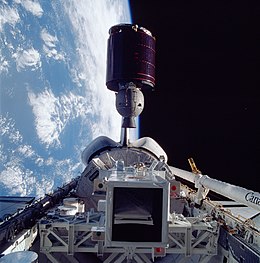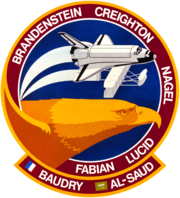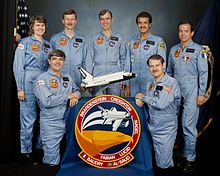
Back STS-51-G Arabic STS-51G Bulgarian STS-51-G Czech STS-51-G Danish STS-51-G German STS-51-G Spanish استیاس-۵۱-گ Persian STS-51-G French STS-51-G Galician STS-51-G HE
 Discovery deploys Morelos-1. | |
| Names | Space Transportation System-18 |
|---|---|
| Mission type | Satellites deployment |
| Operator | NASA |
| COSPAR ID | 1985-048A |
| SATCAT no. | 15823 |
| Mission duration | 7 days, 1 hour, 38 minutes, 52 seconds |
| Distance travelled | 4,693,051 km (2,916,127 mi) |
| Orbits completed | 112 |
| Spacecraft properties | |
| Spacecraft | Space Shuttle Discovery |
| Launch mass | 116,357 kg (256,523 lb) |
| Landing mass | 92,610 kg (204,170 lb) |
| Payload mass | 17,280 kg (38,100 lb) |
| Crew | |
| Crew size | 7 |
| Members | |
| Start of mission | |
| Launch date | June 17, 1985, 11:33:00 UTC (7:33 am EDT) |
| Launch site | Kennedy, LC-39A |
| Contractor | Rockwell International |
| End of mission | |
| Landing date | June 24, 1985, 13:11:52 UTC (6:11:52 am PDT) |
| Landing site | Edwards, Runway 23 |
| Orbital parameters | |
| Reference system | Geocentric orbit[1] |
| Regime | Low Earth orbit |
| Perigee altitude | 353 km (219 mi) |
| Apogee altitude | 359 km (223 mi) |
| Inclination | 28.45° |
| Period | 91.70 minutes |
| Instruments | |
| |
 STS-51-G mission patch  Back: Lucid, Nagel, Fabian, Al Saud and Baudry Front: Brandenstein and Creighton | |
STS-51-G was the 18th flight of NASA's Space Shuttle program, and the fifth flight of Space Shuttle Discovery. The seven-day mission launched from Kennedy Space Center, Florida, on June 17, 1985, and landed at Edwards Air Force Base, California, on June 24, 1985. Sultan bin Salman Al Saud from Saudi Arabia was on board as a payload specialist; Al Saud became the first Arab, the first Muslim, and the first member of a royal family to fly into space.[2] It was also the first Space Shuttle mission which flew without at least one astronaut from the pre-Shuttle era among its crew.
- ^ "Trajectory: STS-51G (1985-048A)". NASA. January 7, 2022. Retrieved January 23, 2022.
 This article incorporates text from this source, which is in the public domain.
This article incorporates text from this source, which is in the public domain.
- ^ "A prince in space" (January/February 1986 ed.). pp. 20–29. Retrieved January 23, 2022.